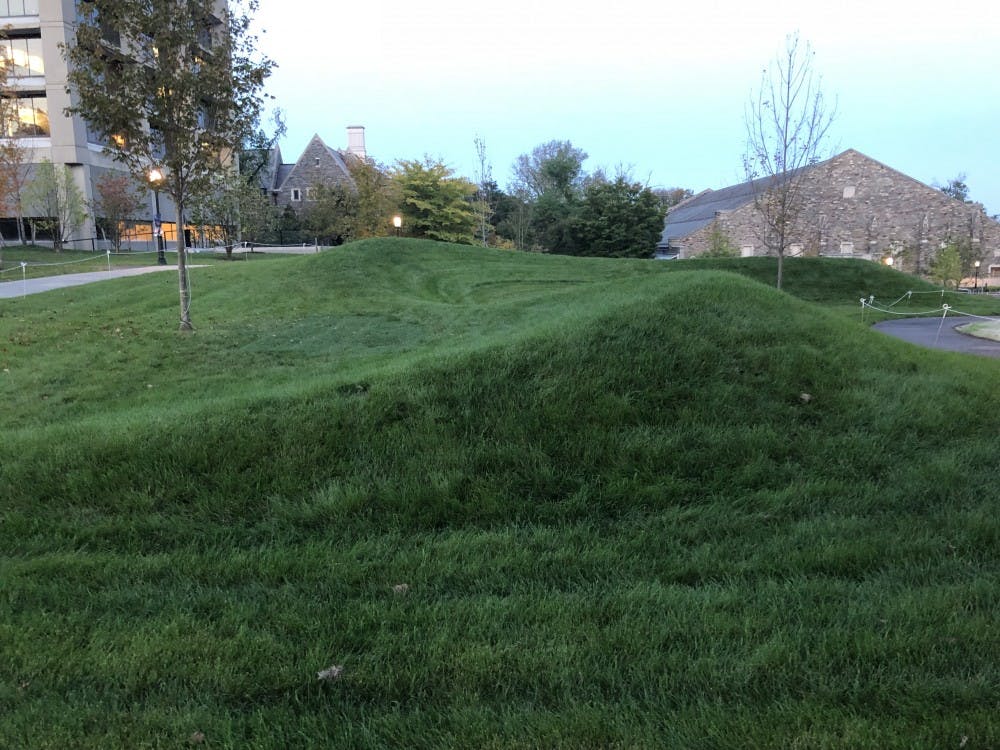The curved grass hills outside of the Lewis Center for the Arts aren’t just ordinary hills — they’re the carefully sculpted first half of artist Maya Lin’s outdoor installation for the University.
The first half, referred to by the University Art Museum as a “folded earth piece,” was completed this past June, while the second half of Lin’s outdoor installation piece — a water table — is set to be completed in late spring before Reunions, according to art museum Campus Collections Manager Lisa Arcomano.
The earth piece is a set of sloping hills that seem to swirl together in front of the Lewis Center. The hills are intentionally subtle, so much so that most people who pass by do not recognize that it is meant to be an art installation, but instead assume it to be part of the natural landscape.
In contrast, the water table will be made of granite and carved to form an “oblate spheroid” with a 12-foot diameter. According to the art museum, the table’s elliptical shape was inspired by the earth’s orbit, the water weir crafted in the fashion of a black hole, and the jet mist granite material chosen to resemble the galaxy’s starry pattern.
The University announced Lin’s commissioning on Sept. 5, 2017. This announcement briefly introduced Lin and her goals to create a “landmark for visitors to campus and an invigorated outdoor setting for students to stage ad hoc performances and enjoy plein air classes.”
Although the University has praised the folded earth piece for its uniqueness and subtle aesthetics, some students have not been as impressed with the installation.
“This art installation is definitely not as obvious or mesmerizing as the Zodiac Heads,” Mike Zupko ’20 said. “They do seem like very unique hills.”
Zupko was referencing the Circle of Animals/Zodiac Heads sculpture by Ai Weiwei currently outside of the New South Building.

Lourdes Santiago ’21 expressed pleasant, if somewhat dubious, surprise upon hearing about the installation.
“They look nice, but I thought they were just hills,” Santiago said.
Conversely, Nadin Mukhtar ’21 praised the hills and saw them as “a metaphor for change.”
“The swirls seem to connect with each other and they do so permanently, which can symbolize feeling stuck in a stage of your life because you’re anxious to move on and aren’t sure of the outcome,” Mukhtar said. “The raised land, or the hills, can signify you finally taking a chance to grow as a person and I think it’s relevant because college is a time full of growth and change.”

In an article distributed by the Princeton University Art Museum, Lin emphasized the importance of geographic awareness and symbolism to create the entire installation “as a site-specific artist,” an artist who makes an installation for a specific gallery or public site.
Lin’s agent did not respond to request for comment.
“Having the chance to create two works in dialogue with one another that respond to the cultural context in which they are placed and allow me to explore two distinct aspects of my work is a unique and challenging opportunity,” Lin said to the art museum.
Lin noted that she took inspiration from Scott Burton’s Public Table for her first water table, the Civil Rights Memorial, and she considers the water table in front of the Lewis Center as her chance to “come full circle.”
Lin achieved national attention after her design for the Vietnam Veterans Memorial was chosen while she was an undergraduate at Yale University. The memorial was completed in 1982 in Washington, D.C. Lin is also a 2016 recipient of the Presidential Medal of Freedom.








